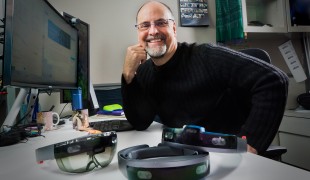- 4162
- 301
- 11
- 8
- 0
- Help Ukraine
About the solution
Back in 2003, Marx Melencio was buying fried rice, as he normally did, with his wife at a roadside store in Manila. All of a sudden, he was unexpectedly shot in the chest and the head in an apparently random attack, with the first bullet hitting him 3mm from his heart and the second missing his brain by 2mm but singed his optic nerve, rendering him blind.
A little while after, when he heard about Tesla, and how artificial intelligence could be used to detect certain objects [on the road], he could only think about how it wiould be fairly straightforward to convert it into detecting human-readable text and for that text to be converted into spoken audio. This made him realize that an old dream of his could become true, as he always dreamt of a way that could describe things that are happening around him at any moment.
This singular aspect is a very important part of being blind as people with impaired vision miss the independence to travel and walk around, take their pet dogs for a walk, buy things on their own or go to the ATM.
Because of this he created VIsION AI Glasses, a pair of 3D printed sunglasses with electronic components; and powered by machine learning, deep learning, and freeware, shared as an open source and DIY device. These glassed provide audible descriptions of visual scenes & objects in front of the user and reads out text in physical objects such as books or signboards. It also has audible & haptic feedback of distance-sensing capabilities with on-demand manual visual assistance via video call access to the user's peers and remote team of sighted PWD agents.
You can find the designs and software of this solution here https://github.com/MXGray/VIsION
This story was adapted from https://www.bbc.com/news/business-39069057 and https://www.awesomefoundation.org/en/projects/129994-vision-ai-glasses-f...
The images were taken from https://www.awesomefoundation.org/en/projects/129994-vision-ai-glasses-f... and https://www.bbc.com/news/business-39069057 as we do not own any of them.
This solution shall not include mention to the use of drugs, chemicals or biologicals (including food); invasive devices; offensive, commercial or inherently dangerous content. This solution was not medically validated. Proceed with caution! If you have any doubts, please consult with a health professional.
DISCLAIMER: This story was written by someone who is not the author of the solution, therefore please be advised that, although it was written with the utmost respect for the innovation and the innovator, there can be some incorrect statements. If you find any errors please contact the patient Innovation team via info@patient-innovation.com
-
-
1100
-
8
-
27906

Der sprechende Stock für Sehbehinderte
WALKING WITH A WALKING AID: Walking with a walking aid
Urban exploration
COMMUNICATION: Communicating, whether by speaking, listening, or other means
Blindness
5 Senses support devices: (glasses, hearing aids, headphones...)
Assistive Daily Life Device (to help ADL)
AI algorithm
Vision problems
Restoring mobility
Promoting self-management
Managing Neurological Disorders
Promoting inclusivity and social integration
Ophthalmology
Solutions for Disabled people
Russian Federation
-
-
-
377
-
0
-
4273

Using AI to allow blind people to find familiar faces
COMMUNICATION: Communicating, whether by speaking, listening, or other means
Social interaction
Blindness
5 Senses support devices: (glasses, hearing aids, headphones...)
Body-Worn solutions (Clothing, accessories, shoes, sensors...)
App (Including when connected with wearable)
AI algorithm
Assistive Daily Life Device (to help ADL)
Difficulty communicating with environment
Confusion
Regaining sensory function
Promoting self-management
Promoting inclusivity and social integration
Improving Speech and Communication
Raise awareness
Ophthalmology
Pediatrics
United States
-
-
-
289
-
0
-
3138

Tim Fitzpatrick founded IKONA Health- a free platform that enhances health literacy throughout the entire kidney disease journey.
CAREGIVING
Renal Disorders (Renal Obstructive Disorders, Renal Structural Abnormalities)
App (Including when connected with wearable)
5 Senses support devices: (glasses, hearing aids, headphones...)
AI algorithm
Strategy/Tip
Website
Enhancing health literacy
Promoting self-management
Manage Medication
Preserving Organ Function
Building Supportive Community Relationships
Promoting inclusivity and social integration
To improve Treatment/Therapy
Preventing (Vaccination, Protection, Falls, Research/Mapping)
Raise awareness
Caregiving Support
General and Family Medicine
Nephrology
Urology
United States
-
 en
en